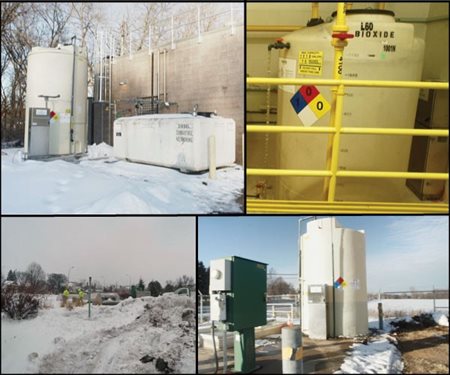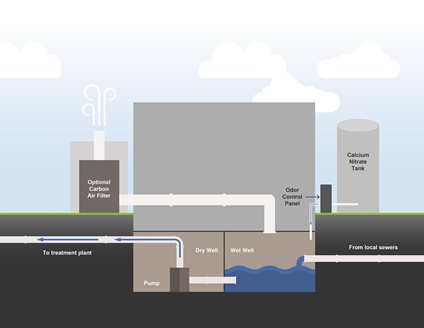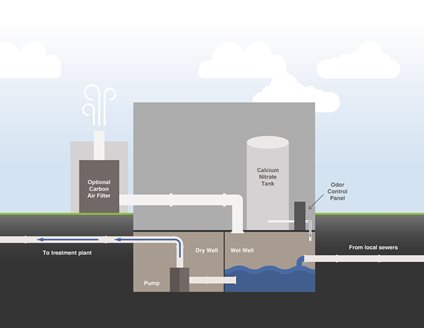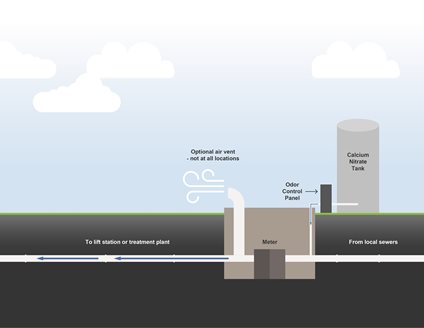Project Description
Metropolitan Council Environmental Services (ES), operator of the metro-area wastewater collection and treatment system, proposes entering into two contracts to support odor and corrosion control within the regional sanitary sewer system. ES’s 600-plus miles of regional sanitary sewers (also known as interceptor sewers) convey wastewater from approximately 5,000 miles of local sanitary sewers to ES’s nine wastewater treatment plants located throughout the region.
ES's proposed contracts include:
- A design-build contract to provide engineering and construction services for odor and corrosion control systems.
- A contract for operations, maintenance, and replacement of 16 odor and corrosion control systems currently located within the interceptor sewer system. This contract would be for 10 years with two potential 5-year renewals.
The contracts would replace an existing arrangement with a vendor providing similar services.
Existing Odor and Corrosion Control
The interceptor sewer system has odor and corrosion control equipment at 16 sites throughout the region, primarily at wastewater pumping stations (also known as lift stations). Liquid calcium nitrate is injected into the wastewater flow at these sites. Calcium nitrate is a natural compound that reduces hydrogen sulfide odors and minimizes corrosion in the system.
The liquid calcium nitrate is stored in tanks on site. Electronic control systems manage flow into the wastewater and monitor tank levels. The system may be installed inside or outside of lift stations or above or below ground at interceptor meter stations. Below are photos and diagrams of the existing systems.
 Photo 1: Collage of existing site photos.
Photo 1: Collage of existing site photos. Clockwise from top left, exterior tank and control at a lift station, interior tank and control at a lift station, underground tank and control at a meter station, and aboveground tank and control at a meter station.
Diagrams
Figures 1 through 4 in PDF format
 Figure 1: Chemical Odor Control system located outside and above grade at ES lift station
Figure 1: Chemical Odor Control system located outside and above grade at ES lift station
 Figure 2: Chemical Odor Control system located within ES lift station (if room is available)
Figure 2: Chemical Odor Control system located within ES lift station (if room is available)
 Figure 3: Chemical Odor Control system located outside and above grade at ES meter station
Figure 3: Chemical Odor Control system located outside and above grade at ES meter station
 Figure 4: Chemical Odor Control system located below grade at ES meter station (location dependent)
Figure 4: Chemical Odor Control system located below grade at ES meter station (location dependent)
Existing Sites
Lift stations (L) and meter stations (M) with odor control equipment or planned for near-term improvements include:
| Site |
Location |
Status |
| L-24 |
4340 Highland Rd., Minnetrista |
Existing |
| L-27 |
402 Hiawatha Ave., Hopkins |
Existing |
| L-38 |
6270 Westedge Blvd., Mound |
Existing |
| L-42 |
2440 Porter Ave., Anoka |
Existing |
| L-59 |
896 Old Crystal Bay Rd. S., Orono |
Existing |
| L-60 |
1598 Stoneridge Cir., Long Lake |
Existing |
| L-63 |
1280 Poplar Ave., Maple Plain |
Existing |
| L-66 |
6220 125th St. W., Savage |
Planning |
| L-67 |
1480 South Ferry Rd., Anoka |
Existing |
| L-68 |
498 Maine St. S., Bayport |
Existing |
| L-70 |
9615 Highway 5, Laketown Township |
Existing |
| L-71 |
600 4th St. E., Chaska |
Existing |
| Roseville |
Cottontail Park, Roseville |
Existing |
| M-132 |
France Ave. S. and Lake St. W., St. Louis Park |
Existing |
| M-224 |
Cul-de-sac on 83rd Ave. N. near Highway 169, Brooklyn Park |
Planning |
| M-232 |
9850 Jefferson Highway N., Brooklyn Park |
Existing |
Typical Site Activities
ES staff activities at these sites are minimal. Operations staff remotely monitor the odor and corrosion control processes. Maintenance staff regularly check and maintain the sites as needed. Calcium nitrate storage tanks are typically refilled monthly, depending on usage, and tank levels are remotely monitored. Exterior tanks include heating elements to prevent freezing in cold weather.
Public Participation
ES wants to hear from the public and potential contractors regarding this odor and corrosion control project. ES policies and procedures include a public hearing on long-term contracts such as this. ES staff held two virtual public information meetings in early April 2021 followed by a virtual public hearing in late April.
Public Information Meetings
Meeting No. 2 - April 8, 2021
Included sites in Minnetrista, Hopkins, Mound, Orono, Long Lake, Maple Plain, Savage, Laketown Township (Waconia area), and Chaska.